The truth about emerging market growth
Many investors like emerging markets because of their impressive growth. But growth doesn't always deliver stock market returns. Cris Sholto Heaton examines why.

Why buy stocks in Asia or South America?
Ask most emerging market investors, and they'll say: "because that's where the growth is".
Yet much of the evidence suggests this isn't a good reason to buy. Several studies argue that high-growth markets don't deliver better returns. Some pundits even stretch this to claim that high growth is actively bad for returns.
MoneyWeek
Subscribe to MoneyWeek today and get your first six magazine issues absolutely FREE

Sign up to Money Morning
Don't miss the latest investment and personal finances news, market analysis, plus money-saving tips with our free twice-daily newsletter
Don't miss the latest investment and personal finances news, market analysis, plus money-saving tips with our free twice-daily newsletter
So who's correct?
Rapid nominal growth seems to lead to higher returns
The chart below plots nominal GDP growth (ie including inflation) against stock market total return (ie including reinvested dividends) from 1987 (when we first have index data for a wide range of markets) to 2011.
The sample includes 35 countries* and at first glance, it seems to be a very good fit, with an r-squared value (which shows how closely two measures correlate with one another) of 0.92. In other words, growth seems to correlate well with investment returns.
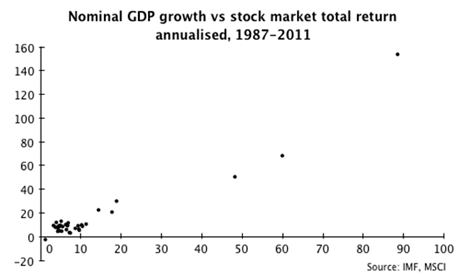
*Argentina, Australia, Austria, Belgium, Brazil, Canada, Chile, Denmark, Finland, France, Germany, Greece, Hong Kong, Indonesia, Ireland, Italy, Japan, Jordan, Korea, Malaysia, Mexico, the Netherlands, New Zealand, Norway, Philippines, Portugal, Singapore, Spain, Sweden, Switzerland, Taiwan; Thailand, Turkey, the UK, and the USA.
Unfortunately, this is very misleading. The relationship is distorted by the points on the right hand side, which are countries that have experienced hyperinflation during this time: Argentina, Brazil and Turkey. They are so large relative to the rest of the data that they skew the fit.
That means that the only real conclusion you can draw from this chart is that if you are concerned about hyperinflation, equities may be the best way to preserve your wealth.
In those three cases - and in the examples of Chile, Indonesia and Mexico, which also suffered very high inflation or brief hyperinflation the stock market ultimately delivered returns greater than inflation.
So how can we get a clear picture? We could remove these outliers. Or we could consider real returns (ie adjusted for the effect of inflation). But there's another approach that reflects what investors are looking for more closely.
If we're investing internationally, our goal is not usually local currency profits. If the market is up 75%, but the currency has halved in value, we're sitting on a 12.5% loss, not a profit.
So instead of looking at this on a local currency basis, it makes more sense to look at it in hard currency terms USD, GBP, EUR, JPY etc. In practice, it's easiest to use USD using other currencies will change the magnitude of the returns, but not the ranking.
But there's no clear relationship between growth in dollars and returns
The chart below shows the relationship recalculated in USD terms. And immediately, the apparent fit disappears. The r-squared value is just 0.15, which suggests the fit is much too weak to base anything on.
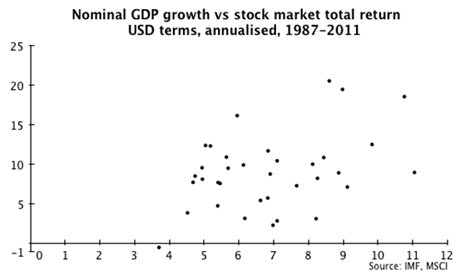
And this seems to be the case regardless of the time period. The chart below extends the comparison back to 1969, from which there is data for 18 markets*. You can see the relationship is just as weak as for 1987-2011.
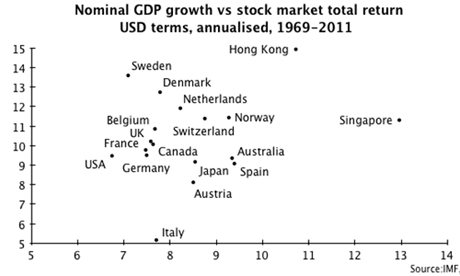
*Australia, Austria, Belgium, Canada, Denmark, France, Germany, Hong Kong, Italy, Japan, the Netherlands, Norway, Singapore, Spain, Sweden, Switzerland, the UK and the USA.
There's nothing in these results to suggest that high growth economies will deliver consistently higher returns. The emerging markets of Hong Kong and Singapore did well from 1969-2011 but so did markets such as Sweden, Denmark and the Netherlands.
Why doesn't growth deliver returns?
Why? One possibility is that investors overpay for growth, bidding up the price of stocks in high growth markets to the point where they don't deliver better returns than less-favoured slow growth ones.
Ideally, we would look at historical valuations to check whether investors were paying a much higher price in Singapore than in Belgium in 1969. Unfortunately, valuation data doesn't stretch back that far. In most cases, we're lucky to have data back to the mid-90s.
Another possibility is that some stock markets are more representative of their domestic economies than others. For example, a country where the stock market contains many foreign listings or multinationals is likely to see a much weaker link between corporate earnings growth and stock market returns.
This seems very plausible when looking at markets such as Sweden. It's hard to see how long-run GDP growth of 7% could deliver returns of 13% in any other way.
Growth matters more in emerging markets
So far, we looked at developed markets and emerging markets combined and the evidence definitely suggests that investing in higher-growth economies offers no clear advantage. But what happens if we consider emerging markets only?
Let's take a look at the 1987-2011 series again, with just the emerging markets included. In addition, let's split out the four points related to South American economies.
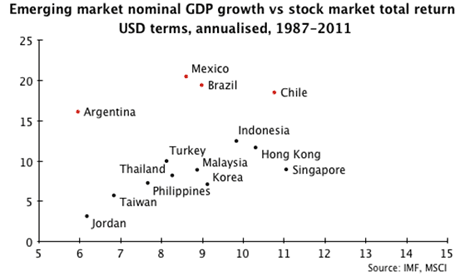
(NB: In the above, I've changed the GDP growth rate for Hong Kong to be the average of the growth rate for Hong Kong and for mainland China. This is to reflect the way that Hong Kong-listed stocks have become increasingly geared to the mainland economy rather than just the local Hong Kong economy.)
If we do this, there seems to be something of a relationship between US dollar GDP growth and stock market total return. The r-squared value is a fairly strong 0.6, although this is a very small sample.
Why should we split out the Latin American markets? Well, in 1987, Argentina, Brazil, Chile and Mexico were still suffering the aftermath of the Latin American debt crisis of the early 1980s.
That meant that their markets were coming off very depressed levels and so delivered exceptional returns relative to GDP growth over the next couple of decades. Had we taken 1998 as the starting point, much of Asia would have been coming off a similarly low base and would have delivered abnormally large returns.
Or consider returns since 2002. At this point in the aftermath of the dotcom crash, most emerging markets were trading on relatively low valuations, yet were in relatively good financial shape.
As you can see below, there appears to be some relationship between growth and returns from this, even before you start identifying any special cases that may be outliers.
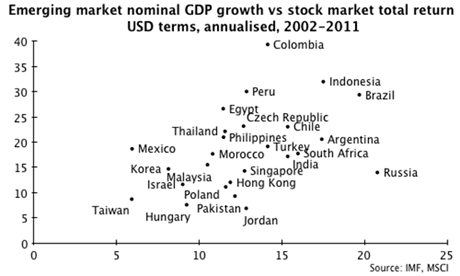
In short, for emerging markets, it seems there has been something of a relationship between GDP growth and returns. It's clearly not perfect but identifying which economies will have the highest nominal USD GDP growth would have helped foreign investors pick some of the better performing markets.
This doesn't mean that it makes sense to invest solely on the basis of growth. If one market trades on a price/earnings (p/e) ratio of five, and one on a p/e of 50, the odds are probably stacked in favour of the first one, however much growth the second delivers.
This article is taken from MoneyWeek Asia, our FREE weekly email on how to invest profitably in the world's fastest-developing and most exciting region. Sign up to MoneyWeek Asia here.
Get the latest financial news, insights and expert analysis from our award-winning MoneyWeek team, to help you understand what really matters when it comes to your finances.
Cris Sholto Heaton is an investment analyst and writer who has been contributing to MoneyWeek since 2006 and was managing editor of the magazine between 2016 and 2018. He is especially interested in international investing, believing many investors still focus too much on their home markets and that it pays to take advantage of all the opportunities the world offers. He often writes about Asian equities, international income and global asset allocation.
Cris began his career in financial services consultancy at PwC and Lane Clark & Peacock, before an abrupt change of direction into oil, gas and energy at Petroleum Economist and Platts and subsequently into investment research and writing. In addition to his articles for MoneyWeek, he also works with a number of asset managers, consultancies and financial information providers.
He holds the Chartered Financial Analyst designation and the Investment Management Certificate, as well as degrees in finance and mathematics. He has also studied acting, film-making and photography, and strongly suspects that an awareness of what makes a compelling story is just as important for understanding markets as any amount of qualifications.
-
 ISS backs Edinburgh Worldwide’s board as Saba questions SpaceX selloff
ISS backs Edinburgh Worldwide’s board as Saba questions SpaceX selloffShareholder advisor ISS has recommended that shareholders vote against Saba’s proposals to replace the board of the Baillie Gifford-managed investment trust
-
 13 tax changes in 2026 – which taxes are going up?
13 tax changes in 2026 – which taxes are going up?As 2026 gets underway, we look at what lies ahead in terms of changes to tax rates and allowances this year and how it will affect you.
